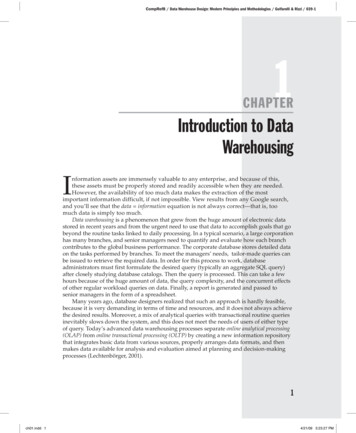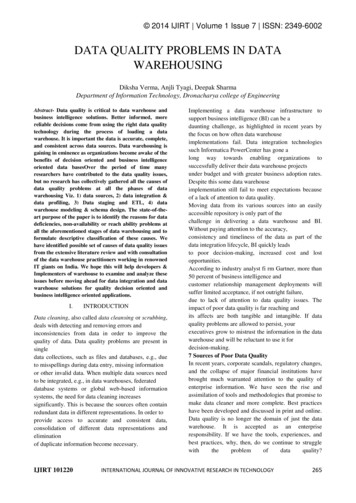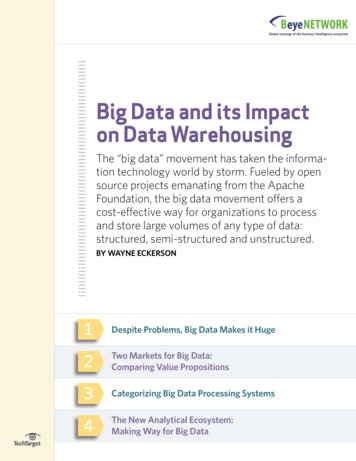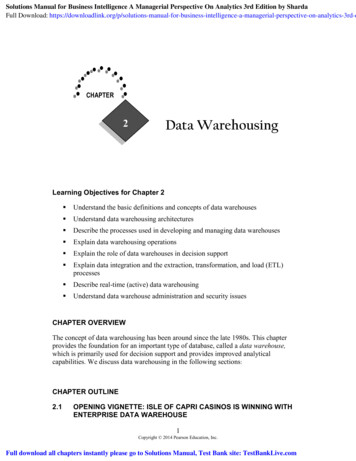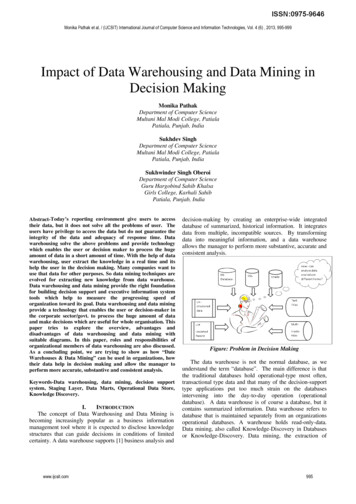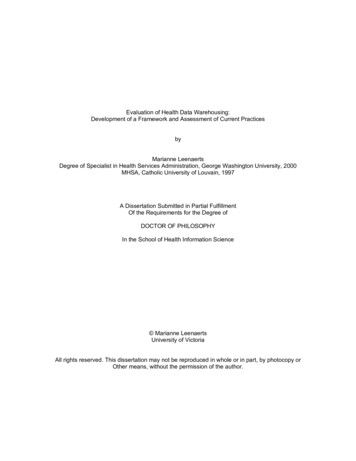
Transcription
Evaluation of Health Data Warehousing:Development of a Framework and Assessment of Current PracticesbyMarianne LeenaertsDegree of Specialist in Health Services Administration, George Washington University, 2000MHSA, Catholic University of Louvain, 1997A Dissertation Submitted in Partial FulfillmentOf the Requirements for the Degree ofDOCTOR OF PHILOSOPHYIn the School of Health Information Science Marianne LeenaertsUniversity of VictoriaAll rights reserved. This dissertation may not be reproduced in whole or in part, by photocopy orOther means, without the permission of the author.
Supervisory CommitteeEvaluation of Health Data Warehousing:Development of a Framework and Assessment of Current PracticesbyMarianne LeenaertsDegree of Specialist in Health Services Administration, George Washington University, 2000MHSA, Catholic University of Louvain, 1997Supervisory CommitteeDr. Andre Kushniruk, (School of Health Information Science)SupervisorDr. Alex Kuo, (School of Health Information Science)Departmental MemberDr. Noreen Frisch, (School of Nursing)Outside Memberi
AbstractSupervisory CommitteeDr. Andre Kushniruk, (School of Health Information Science)SupervisorDr. Alex Kuo, (School of Health Information Science)Departmental MemberDr. Noreen Frisch, (School of Nursing)Outside MemberIf knowledge has been gathered by the practitioners’ community in the area of health data warehousingevaluation, it is mostly relying on anecdotal evidence instead of academic research. Isolated dimensionshave received more attention and benefit from definitions and performance measures. However, very fewcases can be found in the literature which describe how the assessment of the technology can be made,and these cases do not provide insight on how to systematize such assessment.The research in this dissertation is aimed at bridging this knowledge gap by developing an evaluationframework, and conducting an empirical study to further investigate the state of health data warehousingevaluation and the use of the technology to improve healthcare efficiency, as well as to compare thesefindings with the proposed framework.The empirical study involved an exploratory approach and used a qualitative method, i.e. audio-tapedsemi-structured interviews. The interviews were conducted in collaboration with the Healthcare DataWarehousing Association and involved 21 participants who were members of the Association working in aii
mid- to upper-level management capacity on the development and implementation of health datawarehousing. All audio-taped interviews were transcribed and transcripts were coded using a qualitativeanalysis software package (NVivo, QSR International). Results were obtained in three areas. First, thestudy established that current health data warehousing systems are typically not formally evaluated.Systematic assessments relying on predetermined indicators and commonly accepted evaluationmethods are very seldom performed and Critical Success Factors are not used as a reference to guidethe system’s evaluation. This finding appears to explain why a literature review on the topic returns sofew publications. Second, from patient throughput to productivity tracking and cost optimization, the studyprovided evidence of the contribution of data warehousing to the improvement of healthcare systems’efficiency. Multiple examples were given by participants to illustrate the ways in which the technologycontributed to streamlining the care process and increase healthcare efficiency in their respectiveorganizations. Third, the study compared the proposed framework with current practices. Becauseformal evaluations were seldom performed, the empirical study offered limited feedback on theframework’s structure and rather informed its content and the assessment factors initially defined.iii
Supervisory CommitteeAbstractTable of ContentsList of TablesList of FiguresList of AbbreviationsAcknowledgementsChapter I – Research Context and Macro-level Environment1. Health Data Warehousing1.1. Health Data Warehousing Definition1.2. Health Data Warehousing Process2. State of Health Data Warehousing Evaluation3. Research ObjectivesChapter II - Literature review1. Health Data Warehousing Evaluation1.1. Search Strategy1.2. Review Results2. Data Warehousing Evaluation2.1. Search Strategy2.2. Review Results2.2.1. Data Warehousing Evaluation Framework2.2.2. Data Warehousing Evaluation Process2.2.3. Evaluation of the Impact of Data Warehousing on Decision Performance2.2.4. Data Warehousing Testing3. DeLone and McLean Theory of Information System Success3.1. Initial DeLone and McLean Information System Success Model3.2. Model Update3.3. Model Testing and Validation4. Health Information Systems Evaluation Research4.1. Need for Evaluation4.2. Traditional Approaches to Evaluation4.3. Current Approach to Evaluation4.4. Questions Addressed by and Study Designs of Evaluation4.5. Actors Involved in Evaluation4.6. Obstacles to Evaluation ResearchChapter III - Proposed Evaluation Framework1. Evaluation vs. Information Systems Success2. Health Data Warehousing Specificities3. Proposed Framework4. Framework’s Dimensions, Components and Net Benefits4.1. Dimension #1: Organizational Dimension4.2. Dimension #2: Technical Dimension4.3. Dimension #3: Utilization Dimension4.4. Net Benefits5. Framework’s Theoretical References6. Definition of Framework’s Components and FactorsChapter IV – Empirical Study Design1. Methodology1.1. Exploration Research1.2. Exploration Research Techniques2. Participants3. Recruitment4. Setting5. Data Collection6. Ethics Approval7. Data Analysis7.1. Preliminary Coding Structure7.2. Intermediate Coding Structure7.3. Final Coding Scheme7.4. Results GenerationChapter V - Research Findings1. Sample 4555656565757585961646466iv
1.1.1.2.1.3.1.4.Respondents DemographicsOrganizations’ CharacteristicsHealth Data Warehousing EnvironmentsOrganizational Environments1.4.1. Business Goals1.4.2. Sponsorship1.4.3. Resources1.4.4. Types and Number of Users1.4.5. Training, Technical Support and Knowledge Sharing2. Exploratory Findings2.1. State of Health Data Warehousing Evaluation2.2. Use of Data Warehousing to Improve Healthcare Efficiency2.2.1. Waste Reduction2.2.2. Process Improvement2.2.3. Cost Reduction2.3. Use of Data Warehousing for Medical, Clinical and Research Purposes2.4. Raison d’Etre of Health Data Warehousing3. Current Evaluation Practices3.1. User Needs Assessments3.2. Costs Evaluation3.3. Benefits Evaluation3.4. Data Quality Evaluation3.5. Technical Effectiveness Evaluation3.6. Early and Ongoing Generation of Value3.7. Usage Evaluation3.8. Evaluation Components and Factors3.9. Evaluation Methods4. Explanatory Findings4.1. Anecdotal Evidence4.2. Explicit Reasons for the Absence of Evaluation4.3. Implicit Reasons for the Absence of Evaluation4.3.1. Evolving Nature of Health Data Warehousing4.3.2. Hiring of Consulting Firms4.4. What Was Done Instead4.4.1. Monitoring Success vs. Evaluation4.4.2. Assessing Recognition vs. Evaluation4.4.3. Perceived Value vs. Evaluation Results4.5. Opportunities for Improvement and Assessments Considered for the Future5. Summary of FindingsChapter VI - Discussion1. Addressing the Research Objectives and Questions2. Explanatory Value of the Empirical Study2.1. Key Determinants of Health Data Warehousing2.2. Evaluation vs. Monitoring2.3. Evaluation vs. Project Management2.4. Evaluation vs. Recognition, Perceived Value and Success3. Comparison of Current Practices with the Proposed Framework4. Research Limitations4.1. Credibility4.2. Dependability4.3. Transferability5. Future Directions4.1. Implications for Healthcare Organizations4.2. Implications for the Industry4.3. Science and Research Implications4.4. Need for Result-Oriented Cooperation between 26127128129131134Appendix A: Framework’s Theoretical ReferencesAppendix B: Available Survey ItemsAppendix C: Empirical Study - Letter of InvitationAppendix D: Empirical Study - Consent form157160162164v
Appendix E: Empirical Study – Exploratory Coding SchemeAppendix F: Empirical Study – Framework Coding SchemeAppendix G: Empirical Study – Explanatory Coding Scheme168171174vi
List of TablesTable 1Table 2Table 3Table 4Table 5Table 6Table 7Table 8Table 9Table 10Table 11Table 12Table 13Table 14Table 15Table 16Table 17Table 18Table 19Table 20Table 21Factors Definition: Organizational DimensionFactors Definition: Technological DimensionFactors Definitions: Utilization Dimension - Factors Shared by All ComponentsFactors Definitions: Utilization Dimension - Factors Specific to Each ComponentFactors Definition: Individual Net BenefitsFactors Definition: Organizational Net BenefitsInterview GuidePreliminary Coding – Interview Guide Questions 1.1. to 1.10.Preliminary Coding – Interview Guide Questions 2.1. to 2.5.Preliminary Coding – Interview Guide Questions 3.1. to 3.8.Sample CharacteristicsOrganizations’ CharacteristicsFrequency of Vendor ProductsEvaluation Components and FactorsEvaluation MethodsData Warehousing EvaluationData Warehousing ManagementSummary of Findings on the State of Health Data Warehousing EvaluationSummary of Findings on the Use of Data Warehousing to Improve HealthcareEfficienciesSummary of Findings on Evaluation Dimensions, Factors and MethodsMonitoring vs. 09109116vii
List of FiguresFigure 1Figure 2Figure 3Figure 4Figure 5Figure 6Figure 7Health Data Warehouse ArchitectureProposed Health Data Warehousing Evaluation FrameworkFramework’s Components and FactorsOrganizations’ Key IndicatorsWord Cloud of top 15 wordsTop 5 Evaluation TermsDistribution of Evaluation Terminology5373868757676viii
List of AbbreviationsCSFETLGISHDWAMeSHMPPOLAPROISQLSWOT AnalysisTAMTEAMCritical Success FactorExtract Transform LoadGeographic Information SystemsHealthcare Data Warehousing AssociationMedical Subject HeadingMassively Parallel ProcessingOn-Line Analytical ProcessingReturn on InvestmentStructured Query LanguageStrengths, Weaknesses, Opportunities, and Threats analysisTechnology Acceptance ModelTotal Evaluation and Acceptance Methodologyix
AcknowledgementsThe guidance and assistance provided by my Supervisor, Dr. Andre Kushniruk, were instrumental inaccomplishing the research. His knowledge of health information systems’ evaluation was verybeneficial. Equally important was the input of my Committee Members, Dr. Noreen Frisch and Dr. AlexKuo. They both added a complementary perspective to my work, the former from a medical, clinical andnursing standpoint, and the latter from a technical point of view. The financial support provided by theUniversity of Victoria’s School of Health Information Science and the Government of British Columbiagreatly facilitated the conduct of the empirical study.The existence of the research itself was initially supported by Dr. Dennis Protti who recommended that Ipursue a doctorate degree, endorsed my topic of interest, and introduced me to someone he presentedas “the best mentor I could ever hope for.” The opportunity to benefit from Dale Sanders’ knowledge andexperience were indeed an unsurpassable experience. His intellectual and personal qualities wereinvaluable. His relentless attention and immediate availability throughout this venture made atremendous difference. More importantly, Dale Sanders introduced me to the Healthcare DataWarehousing Association, the organization which enabled the conduct of the empirical study under thebest possible conditions. Over the past three years, through my participation at the organization’s annualconference, I was also given the opportunity to present and discuss my work with those involved in healthdata warehousing on a daily basis. The research would have never come to fruition without the time andeffort contributed by Lee Pierce, Suzan McFarland and those who participated in the empirical study.The proficiency and dedication of Faye Wolse were instrumental in achieving optimum use of the dataanalysis software, while the expertise, talent and communications skills of my editor, Mayne Ellis, enabledme to produce materials of high editorial quality.Lastly, reaching the finish line in a timely fashion would have never been possible without the support ofmy co-workers at RebalanceMD who never questioned and systematically accommodated the timerequirements of this project.x
“You might ask: “Why evaluate?” For years, health IT has been implemented with the goals of improvingclinical care processes, health care quality, and patient safety. In short, it’s been viewed as the right thingto do. In those early days, evaluation took a back seat to project work. Frequently, evaluations were notperformed at all – at a tremendous loss to the health IT field. Health IT projects require large investments,and stakeholders increasingly are demanding to know both the actual and future value of these projects.As a result, we as a field are moving away from talking about theoretical value, to a place where wemeasure real value. We have reached a point where isolated studies and anecdotal evidence are notenough – not for our stakeholders, nor for the health care community at large. Evaluations must beviewed as an integral piece of every project, not as an afterthought.”Caitlin M. Cusack, M.D., M.P.H.Center for IT LeadershipEric G. Poon, M.D., M.P.H.Brigham and Women’s HospitalCusack CM, Poon EG. Health Information Technology Evaluation Toolkit. Prepared for the AHRQNational Resource Center for Health Information Technology under contract No. 290-04- 0016. AHRQPublication No. 08-0005-EF. Rockville, MD: Agency for Healthcare Research and Quality. October 2007.xi
CHAPTER I – RESEARCH CONTEXT AND MACRO-LEVEL ENVIRONMENTRegardless of funding mechanisms, the percentage of the gross national product devoted to healthcarehas risen to unprecedented levels over the past decade. The reasons most commonly cited range from arise in the prevalence of treated conditions to an increase in the volume and intensity of services as wellas the aging population. A cause far less investigated is the inefficiency of healthcare systems. It isacknowledged that 50,000 to 100,000 lives are lost each year in the US as a result of medical error(Bodenheimer, 2005; Bush, 2007; Orszag, 2008). Also indicative of inefficiencies are the wide variationsin practices, outcomes and costs that can be found across providers, geographical regions and patients(Bodenheimer, 2005; Bush, 2007; Orszag, 2008). In 2008, the US Congressional Budget Officeestimated that an average US 700 billion, an equivalent of 5% of the GDP, was spent each year on carethat is not shown to improve health outcomes (Bodenheimer, 2005; Bush, 2007; Orszag, 2008). Whenhigher than average expenses occur, it appears that the extra share of spending is actually wasteful as itdoes not correspond to any improvement in health status. Waste is considered a measure of inefficiencyand can be found throughout the healthcare system from the overuse of procedures not proven usefuland the underuse of treatments known to be effective to quality defects resulting in tests being redone oreven in detrimental health effects (Bentley, Effros, Palar, & Keller, 2008).Addressing healthcare inefficiencies and waste requires something that is not yet readily available.Measures are still pieced together from various sources. They do not cover extensively how much isbeing spent and where, and they do not systematically assess the clinical conditions and practices thatdrive expenditures growth (Fodeman & Book, 2010). The ability to link data on spending, medical care,conditions and other key indicators in a timely fashion and on a large scale is still missing as well.(Fodeman & Book, 2010).The absence of reliable measures in turn leads to a lack of frameworks to properly categorizeinefficiencies and determine strategies to address them. It also impacts the use of managementphilosophies which have been successful in other sectors of the economy, e.g. Continuous Process1
Improvement. In contrast, healthcare outcomes often remain linked to individuals and isolated causessuch as physician negligence and technical issues rather than processes themselves (Laffel &Blumenthal, 1989). Ultimately, it results in the persistence of funding mechanisms based on volumerather than the efficient provision of care (Bentley et al., 2008; Fodemand & Book, 2010).1. Health Data WarehousingMeasures and the ability to link data are part of a broader context: information, i.e. the accumulation oftransactional data into a meaningful context. When properly structured and made available to targetedusers in a timely fashion, information becomes knowledge (Bose, 2003). This next level of understandingoriginates in the collection of evidence, which is in essence the purpose of data warehousing and theprerequisite for improving processes (Sanders & Protti, 2008). Not only can information technologyfacilitate the collection of health data, but with the use of health data warehouses, it can also facilitate thequery and broad analysis of such data. By making large amounts of clinical, financial and operationaldata available in customized and useable formats, health data warehouses help uncovering criticalutilization patterns, they facilitate the integration of demographic and consumer data collected bytransactional systems, and they help shortening the turnaround time to provide the data needed foranalyses. New knowledge can then be generated, opportunities for improvement can be unveiled andthe efficiency of healthcare systems can be increased (Goldstein, 2000).1.1. Health Data Warehousing DefinitionA data warehouse is a “centrally managed and easily accessible copy of data collected in the transactioninformation systems of a corporation. These data are aggregated, organized, catalogued and structuredto facilitate population-based queries, research and analysis” (Sanders & Protti, 2008).Best known as the “father of data warehousing,” Bill Inmon characterizes the data warehouse as “asubject-oriented, integrated, non-volatile and time-variant collection of data in support of management’sdecisions.” (Bush, 2007) The data is not organized to support specific applications such as laboratory orimaging systems, but rather by subjects, i.e. patients, and is therefore subject-oriented. The dataoriginates in multiple operational systems, and is integrated both by definition and content. The purpose2
of a data warehouse is to extract data from operational systems and transform it into formats suitable fordata analysis. As opposed to operational systems in which data is deleted when it is no longer needed bya particular application, data warehouses retain data over time. It is the non-volatility of the data thatmakes historical analysis possible. As opposed to operational systems which store the most recentversion of the data, data warehouses keep track of it, including a history of the changes that took place.Time-variance enables trends analysis over time. Finally, the purpose of the data is to improvemanagement by gaining a better understanding of the enterprise (Inmon, 2005).Several attributes characterize a data warehouse. A data warehouse is large by definition, i.e. it containsup to thousands of terabytes of data or more. The system offers a historical perspective, i.e. it can coverup to 30 years or more. The technology integrates data from several transaction information systems, i.e.data is collected from source systems such as billing, registration or scheduling. The analysis providedby a data warehouse spans across multiple business processes, e.g. the data pertaining to a billingsystem will be compared against the data contained in a scheduling system. A data warehouse providesan explorative approach. It offers insight into areas that have not yet been investigated and issues thathave not yet been anticipated. The output of the data warehouse takes the form of reports and metrics.From the collection of the data to its transformation for query purposes and the production of reports, datawarehouses require the intervention of specialized staff (Sanders & Protti, 2008).The key role of a data warehouse is to provide decision-makers with the compelling business intelligencethat enables them to understand problems, discover opportunities, and measure performance. Toeffectively play this role, the data warehouse must integrate the internal and external data acquired overtime and translate it into current conditions. In doing so, the data warehouse is the instrument thatenables decision makers to locate and apply relevant data, and helps them to predict and measure theimpact of their decisions over time (March & Hevner, 2007; Pedersen & Jensen, 1998).3
1.2. Health Data Warehousing ProcessIn order to become a real organizational asset leveraged throughout the organization, data must beproperly identified and inventoried. It must be extracted, organized, combined, stored and managed in asecured manner. Based on user requirements and reporting expectations, a master data model isestablished as the foundation for the warehousing effort which, as shown on Figure 1, encompasses fourfunctions.Data Acquisition. A data warehouse acquires its data from the organization’s operational systems aswell as from systems external to the organization such as suppliers and regulatory institutions. Not onlymust the data be extracted from the source systems, but it must be cleaned and transformed to conformto the standardized architecture, and it must be loaded into the data warehouse. Known as extracttransform-load or ETL, this function is at the core of data warehousing. Equally central is theestablishment of robust metadata, i.e. the comprehensive documentation of the data and all processesrelated to the data warehouse including data models, a data dictionary and ETL load statistics which mustbe made readily available to the user community (Adelman, 2003; Imhoff, Galemmo, & Geiger, 2003;Inmon, Imhoff, & Terdeman, 1999; Sakaguchi & Frolick, 1997).Data Warehouse Population. In order to be presented to users in a uniform and consistent manner, thedata that flows in the data warehouse must follow a consistent and logical process. Based on theorganization’s requirements and experience, the storage of the data usually follows the dimensionalapproach, which stores data in a form similar to both its true dimensionality and the form needed at thetime of reporting, or the relational approach, which relies on relational database management principles(Inmon et al., 1999; Sakaguchi & Frolick, 1997).4
Figure 1 – Health Data Warehouse ArchitectureData Marts Creation. To better address the needs of specific users, smaller subsets of data are drawnfrom the data warehouse in the form of custom-designed databases and offer a multidimensional view ofthe data such as by service or location as well as over time. Such subsets enable a better understandingand greater probing of the data, and offer faster responses to queries (Hristovski, Rogac, & Markota,2000).Information Access. In order to meet the information needs of the end-users, a series of analysis andreporting tools must be made available that leverage the latest technology with minimal overlap.Structured Query Language (SQL) queries are used on an ad-hoc basis and involve specific interfaces.On-Line Analytical Processing (OLAP) is used to “slice and dice” large volumes of data, and providesanalysts with an interface to manipulate views and levels of aggregation. Web reporting enables theselection and presentation of customized reports from web interfaces. Dashboards and scorecards utilizegraphical interfaces to present key indicators and quality measures and allow drilling down into top-levelmeasures to assess their components. Data mining techniques apply algorithms to summarize, modeland cluster data with the aim of identifying novel and potentially useful correlations and patterns in data.Statistical analysis can be applied to the data, e.g. measures of central tendency, analysis of variance,regression, and time series analysis. Geographic Information Systems (GIS) provide geographic displaysof data and can be used, among others, to analyze where resources are needed for specific products and5
services, or to demonstrate geographic variations in distribution or consumption patterns (Akhtar, Dunn &Smith, 2005).2. State of Health Data Warehousing EvaluationIf the anticipated benefits of data warehouses are quite significant, the system requires ample financialand technical resources, as well as qualified labor and time. By spanning across entire organizations, it issubject to multiple individual and organizational factors. Its dependency on existing source systemsrenders the quality of its output vulnerable, and since its output is in the form of reports and metrics usedfor decision support purposes, numerous and potentially critical repercussions are associated to its use.The level of complexity is further increased when data warehousing is applied to healthcare. Medicaldata is more voluminous and heterogeneous than the data found in any other economic sector, and inorder to cover all aspects of the care process, data warehouses must address areas as varied as clinicalresearch, treatment effectiveness, financial analysis and customer relationship.If the literature extols the virtues of health data warehouses, there is little evidence of their assessment.As indicated in Chapter II, even when extended to sectors not related to healthcare, the review of thecurrent literature returns very few publications on data warehousing evaluation. Only isolated dimensionssuch as data and system quality or user satisfaction have received more attention and benefit fromdefinitions and performance measures (Curtis & Joshi, 1998; Wixom & Watson, 2001). Wheneverknowledge has been gathered by the practitioners’ community, it is mostly relying on anecdotal evidence.Furthermore, very few cases can be found that describe how the assessment of the technology can bemade, and these cases do not provide insight on how to systematize such assessment.In lieu of evaluation principles and methods, the concept of success often serves as a basis to thesystem’s assessment. As discussed in Chapter V, Critical Success Factors (CSFs) are an application ofsuch concept. CSFs are elements identified as vital in order for an organization or project to achieve itsmission and reach successful targets. Failure to meet the objectives associated with CSFs results in thefailure of the project or organization (Watson, Gerard, Gonzalez, Haywood, & Fenton, 1999). Theresearch departed from CSFs. Not only does this practice reduce assessments to a dichotomous6
approach, but it relies on ill-defined and contentious concepts. Data warehouses can be successful ifimplemented within budget, but at the same time their effective use may not. The converse can equallybe true, or the technology may be highly appreciated by users but nonetheless not widely used. In otherwords, some CSFs are identified without being empirically used and some of the factors used involvedifferent measuring mechanisms. The notion of success has also been the object of extensive academicresearch. For over twenty years, DeLone and McLean have attempted to define information systemssuccess along with the dimensions of success themselves. Their theoretical model was chosen as afoundation to the research described in this dissertation. The latter also departed from the DeLone andMcLean theory. If its model and the empirical studies conducted to apply it have helped establish a set ofsuccess factors and measures, a consensus is still lacking as to what the concept of success entails. Inthe absence of such consensus, the use of factors such as the actor for whom success is defined andrather his/her view can prevail within an organization persists. As a result, the assessment of informationsystems remains often unaddressed, and the comparison of systems across organizations remainslargely impossible (Berg, 2001; Forsythe & Buchanan, 1991).3. Research ObjectivesRather than attempting to determine success, the research in this dissertation focused on evaluation. Aliterature review was conducted on the evaluation of health data warehousing, on applicable informationsystems theories and on evaluation research. The review results are presented in Chapter II. Anevaluation framework was developed and is presented in Chapter III. An empirical study was conductedto further investigate the state of health data warehousing evaluation and the use of the system toimprove healthcare efficiency. The empirical study design is presented in Chapter IV and the findings aredescribed in Chapter V. Lastly, the findings were compared with the proposed framework. Currentevaluation practices and the comparison are discussed in Chapter V and VI.The empirical study addressed the following three questions:7
Research Question #1: What is the state of health data warehousing evaluation?Data warehouses are known to be effective enablers of evidence-based decision making. Up until thecurrent dissertation research, whether or not the technology was formally evaluated remained largelyunknown. It was therefore of paramount importance to address the following questions:1.1. Do healthcare organizations formally evaluate their data warehouse?1.2. Is health data warehousing evaluation perceived as necessary?1.3. When conducted, how are the assessments performed and what do they entail?1.4. Do the assessments rely on Critical Success Factors?Research Question #2: How is data warehousing used to improve healthcare ef
2.1. State of Health Data Warehousing Evaluation 74 2.2. Use of Data Warehousing to Improve Healthcare Efficiency 78 2.2.1. Waste Reduction 78 2.2.2. Process Improvement 79 2.2.3. Cost Reduction 81 2.3. Use of Data Warehousing for Medical, Clinical and Research Purposes 81 2.4. Raison d'Etre of Health Data Warehousing 83 3.
